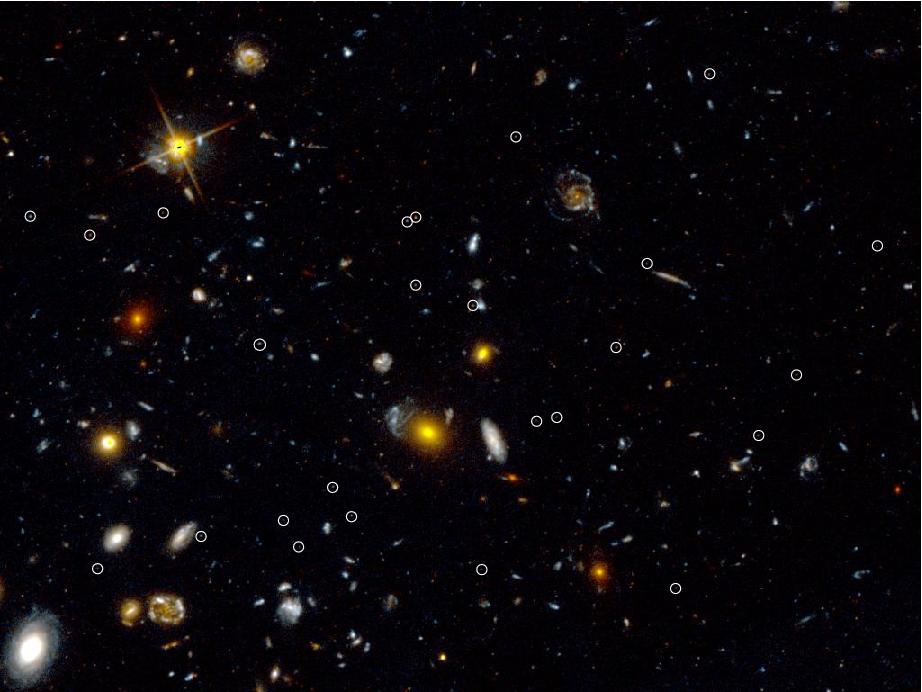







| BOOKS | F. A. Q. | ARTICLES | TALKS | ABOUT KEN | DONATE | BEYOND OUR KEN |
|---|
By Ken Croswell
October 23, 2006

Image by Benjamin Williams et al., using the Hubble Space Telescope.
Most of the intergalactic stars in the Virgo cluster are old
and surprisingly metal-poor, say astronomers who have used the
Hubble Space Telescope to discover thousands of such stars. The
low metallicity suggests that the stars were born both in small
Virgo galaxies which disintegrated and at the edges of the large
galaxies which tore the small ones apart.
Although most stars, including the Sun, reside in a galaxy, collisions between galaxies can catapult stars out of their homes. The danger is especially great in galaxy clusters. During the 1990s, astronomers discovered intergalactic stars in the Virgo and Fornax clusters, the two nearest galaxy clusters to Earth.
Now Benjamin Williams of Pennsylvania State University and his colleagues have used the Hubble Space Telescope's Advanced Camera for Surveys to discover 5,300 intergalactic stars in the Virgo cluster. Most of the stars are red giants about 52 million light-years from Earth.
Williams and his colleagues chose to observe an apparently empty field located between the two giant elliptical galaxies M86 and M87, both Virgo cluster members. The field was 37 arcminutes, or 550,000 light-years, southeast of M86 and 40 arcminutes, or 620,000 light-years, west-northwest of M87. The field's epoch 2000 coordinates were right ascension 12 hours, 28 minutes, and 10.8 seconds; declination +12 degrees, 33 minutes, and 20 seconds.
 The image here shows a small portion of this field that
measures 1.0 arcminute by 0.8 arcminutes, or 15,000 by 12,000
light-years. The many galaxies in the image lie far beyond the
Virgo cluster, but the white circles indicate probable
intergalactic stars that belong to the cluster.
The image here shows a small portion of this field that
measures 1.0 arcminute by 0.8 arcminutes, or 15,000 by 12,000
light-years. The many galaxies in the image lie far beyond the
Virgo cluster, but the white circles indicate probable
intergalactic stars that belong to the cluster.
By analyzing brightness and color, Williams' team finds that 70 to 80 percent of Virgo's intergalactic stars are ancient--older than 10 billion years--and have a metallicity that ranges from 0.3 to 20 percent solar, with a median metallicity of 5 percent solar and a mean metallicity of 10 percent solar. Metallicity is a star's abundance of elements heavier than helium.
"The dominant low-metallicity component is a surprise," write the astronomers in work to appear in The Astrophysical Journal. But the low metallicity also lends a clue to the stars' origin.
One source of the stars may be disrupted dwarf galaxies. Because dwarf galaxies have few stars, they create fewer heavy elements than large galaxies like the Milky Way; therefore, all their stars are metal-poor. Furthermore, because of their small size, dwarf galaxies have so little gravity that collisions with large galaxies can tear them apart.
But large galaxies themselves may also be a source of Virgo's intergalactic stars, because the edges of such galaxies contain metal-poor stars, too. Thus, collisions could strip some of these metal-poor stars from the large galaxies, contributing to Virgo's intergalactic population.
"Just finding the stars doesn't tell you what kind of galaxies these stars come from or when they were formed," says Tom Theuns of the University of Durham in England, who in the 1990s discovered intergalactic stars in the Fornax cluster. "That's why this paper is interesting: it looks at the properties of the stars in more detail."
Williams and his colleagues say 20 to 30 percent of Virgo's intergalactic stars are younger and more metal-rich than the others. Some of them have as high a metal abundance as the Sun.
However, the metal-poor stars tend to group together, whereas the metal-rich stars have a smoother distribution. The clumpy distribution of the metal-poor stars may suggest that these stars did arise in small galaxies and still move through space together, even after their home galaxies were destroyed. Or the metal-poor stars may have been torn from their galaxies only recently, giving them little time to mix with the other stars.
Although the Sun and Earth currently reside in the Milky Way, their galactic home is threatened by the approach of the Andromeda Galaxy, which may collide with the Milky Way billions of years from now. The collision will eject some stars into the void. If the Sun happens to be one of the unfortunate outcasts, it will sail away from the Milky Way's many stars, and our future descendants will confront a starless night sky.
Ken Croswell is an astronomer and the author of Magnificent Universe and The Universe at Midnight.
"Magnificent Universe by Ken Croswell is elegant and eloquent."--Kathy Sawyer, The Washington Post. See all reviews of Magnificent Universe here.
"The Universe at Midnight is vastly entertaining and enjoyable, as well as informative."--Sir Patrick Moore, New Scientist. See all reviews of The Universe at Midnight here.
| BOOKS | F. A. Q. | ARTICLES | TALKS | ABOUT KEN | DONATE | BEYOND OUR KEN |
|---|